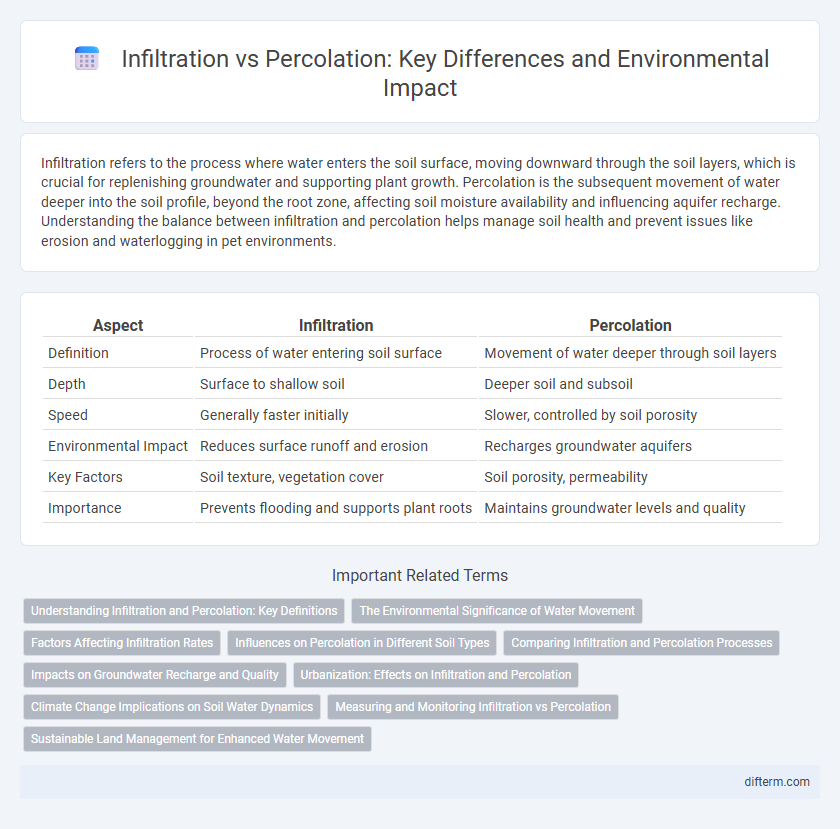Infiltration refers to the process where water enters the soil surface, moving downward through the soil layers, which is crucial for replenishing groundwater and supporting plant growth. Percolation is the subsequent movement of water deeper into the soil profile, beyond the root zone, affecting soil moisture availability and influencing aquifer recharge. Understanding the balance between infiltration and percolation helps manage soil health and prevent issues like erosion and waterlogging in pet environments.
Table of Comparison
| Aspect | Infiltration | Percolation |
|---|---|---|
| Definition | Process of water entering soil surface | Movement of water deeper through soil layers |
| Depth | Surface to shallow soil | Deeper soil and subsoil |
| Speed | Generally faster initially | Slower, controlled by soil porosity |
| Environmental Impact | Reduces surface runoff and erosion | Recharges groundwater aquifers |
| Key Factors | Soil texture, vegetation cover | Soil porosity, permeability |
| Importance | Prevents flooding and supports plant roots | Maintains groundwater levels and quality |
Understanding Infiltration and Percolation: Key Definitions
Infiltration refers to the process where water enters the soil surface and begins to move downward into the soil layers, influenced by soil texture, structure, and vegetation cover. Percolation is the subsequent movement of water through the soil profile beyond the root zone, affecting groundwater recharge and soil moisture distribution. Understanding these processes is crucial for managing irrigation, preventing soil erosion, and maintaining ecosystem health.
The Environmental Significance of Water Movement
Infiltration refers to the process where water enters the soil surface, while percolation describes the downward movement of water through soil layers. This distinction is crucial for groundwater recharge, as efficient infiltration and percolation reduce surface runoff and prevent soil erosion. Proper understanding of these processes supports sustainable water management and helps maintain ecosystem health by regulating soil moisture and filtering pollutants.
Factors Affecting Infiltration Rates
Soil texture, structure, and moisture content significantly influence infiltration rates, with sandy soils exhibiting higher infiltration compared to clay soils due to larger pore spaces. Vegetation cover and land use impact infiltration by altering surface roughness and organic matter content, enhancing water absorption. Topography and rainfall intensity also affect infiltration, where steep slopes and intense precipitation reduce water penetration by promoting runoff.
Influences on Percolation in Different Soil Types
Soil texture and structure significantly influence percolation rates, with sandy soils exhibiting rapid water movement due to large pore spaces, while clay soils demonstrate slower percolation caused by fine particles and compactness. Organic matter content enhances soil porosity and water retention, thereby affecting the percolation dynamics across varied soil types. Soil compaction and moisture levels also alter hydraulic conductivity, impacting water infiltration depth and percolation efficiency.
Comparing Infiltration and Percolation Processes
Infiltration refers to the process where water enters the soil surface, while percolation describes the movement of this water downward through soil layers. Infiltration rate depends on soil texture, vegetation cover, and surface conditions, whereas percolation rate is influenced by soil permeability and pore connectivity. Understanding the balance between infiltration and percolation is crucial for effective groundwater recharge and managing surface runoff in environmental conservation.
Impacts on Groundwater Recharge and Quality
Infiltration determines the initial movement of water into the soil, directly influencing the rate and volume of groundwater recharge, while percolation governs the deeper passage of water through soil layers affecting its chemical composition and contaminant filtering. Effective infiltration enhances groundwater replenishment by allowing surface water to enter aquifers, whereas poor infiltration can lead to surface runoff and reduced recharge. Percolation through permeable soils improves groundwater quality by natural filtration, but excessive or rapid percolation in contaminated zones risks groundwater pollution.
Urbanization: Effects on Infiltration and Percolation
Urbanization significantly reduces infiltration rates due to increased impervious surfaces such as roads and buildings, which limit water absorption into the soil. This decrease in infiltration disrupts natural percolation processes, leading to higher surface runoff and increased risk of urban flooding. Reduced percolation also affects groundwater recharge, compromising long-term water availability in urban environments.
Climate Change Implications on Soil Water Dynamics
Infiltration refers to the process of water entering the soil surface, while percolation describes the downward movement of water through soil layers. Climate change intensifies soil water dynamics by altering precipitation patterns, leading to increased infiltration rates during heavy rainfall and enhanced percolation impacts on groundwater recharge. Understanding these processes is crucial for managing soil moisture availability and mitigating risks of droughts and floods under shifting climate conditions.
Measuring and Monitoring Infiltration vs Percolation
Measuring infiltration involves quantifying the rate at which water enters the soil surface, typically using infiltrometers or double-ring tests to capture surface soil absorption capacity. Percolation measurement focuses on tracking water movement through soil layers, often monitored with soil moisture sensors or lysimeters to assess vertical water flow and retention. Accurate monitoring of both processes is essential for managing irrigation, predicting runoff, and optimizing groundwater recharge strategies.
Sustainable Land Management for Enhanced Water Movement
Infiltration is the process by which water enters the soil surface, while percolation refers to the downward movement of water through soil layers. Sustainable land management techniques, such as maintaining vegetation cover and enhancing soil structure, improve infiltration rates and promote efficient percolation, reducing surface runoff and increasing groundwater recharge. Optimizing these processes supports water conservation and resilience against droughts in agricultural and natural ecosystems.
infiltration vs percolation Infographic

 difterm.com
difterm.com